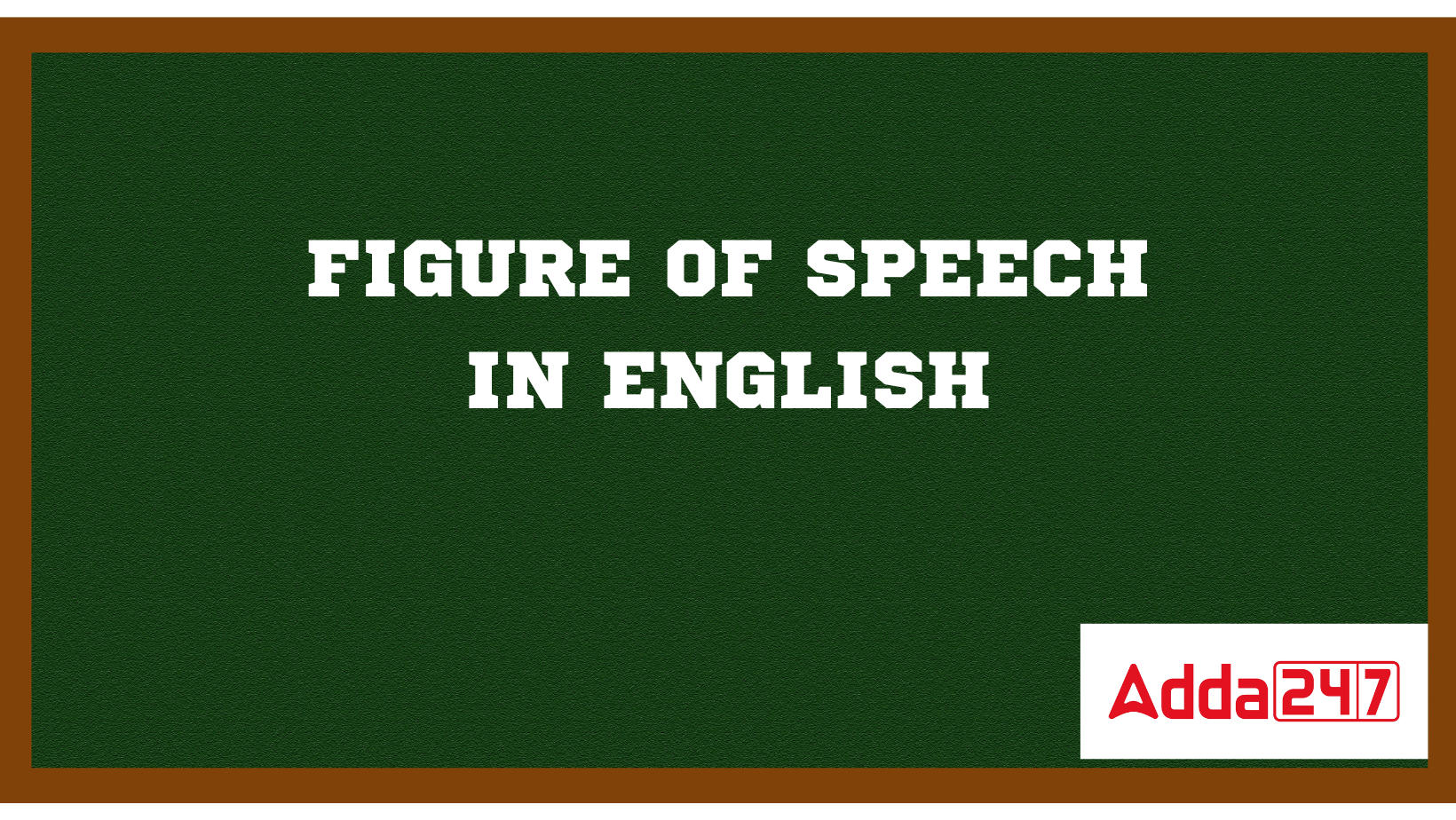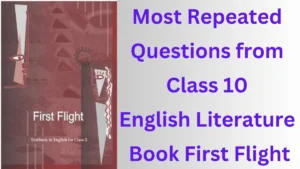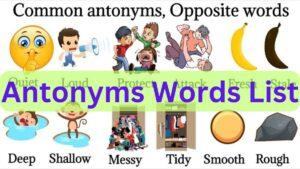Table of Contents
Figure of Speech
figure of speech, any intentional deviation from a literal statement or common usage that emphasizes, clarifies, or embellishes both written and spoken language.
Figure of Speech in English
Figure of Speech- There are approximately fifteen to twenty figures of speech in English grammar. However, some of them are utilised more frequently than the others. Let’s examine the most frequently employed figurative language.
| Simile | Antithesis |
| Metaphor | Oxymoron |
| Personification | Epigram |
| Apostrophe | Irony |
| Alliteration | Pun |
| Assonance | Metonymy |
| Hyperbole | Synecdoche |
| Euphemism | Transferred Epithet |
Figure of Speech in Poetry Meaning
A figure of speech is a phrase designed to elicit a stronger response from your reader or listener. Making contrasts, associations, exaggerations, and comparisons are all included. Additionally, it paints a much clearer image of your message.
To get a better understanding of what a figure of speech is, let’s look at how it is defined in several dictionaries.
Figure of Speech Definition
The Oxford Learner’s Dictionary describes a figure of speech as “a word or phrase employed in a way different from its regular meaning in order to produce a specific mental picture or impression.” A figure of speech is “a phrase that utilises words to mean something distinct from their ordinary meaning,” according to the Cambridge Dictionary. A figure of speech is defined as “a phrase or word that is employed with a metaphorical rather than a literal sense” by the Collins Dictionary.
A figure of speech is described as “a style of phrase (such as a simile or metaphor) used to transmit meaning or heighten the effect, frequently by comparing or connecting one item with another that has a meaning or connotation recognisable to the reader or listener” in the Merriam-Webster Dictionary. A figure of speech is defined as “a phrase in which the words are employed symbolically, not in their usual literal meaning” by the Macmillan Dictionary.
Figures of Speech Class 10 Importance
It improves how beautiful the text is. It deepens the meaning of the text and makes the reader wonder. It gives the writer’s words more vitality. The use of figures of speech not only reveals the author’s intention but also explains why he chose certain words.
It gives the text flavour and greatly improves the reader’s enjoyment of it.
There are five main types of figures of speech, which are listed below:
Figures of resemblance: It is also known as the figure of relationship. It is made up of simile, metaphor, or kenning.
Figures of emphasis: It is also known as a figure of an understatement. It is made up of hyperbole.
Figures of sound: It uses alliteration.
Verbal games: It is also known as gymnastics. It includes puns.
Errors: It is created of malapropism and usually generated because of blunder.
Figure of Speech Examples with Answers for Class 10, 12
Different types of figures of speech with examples are discussed below in detail
First Figure of Speech: Simile
The basic purpose of a simile, which is a figure of speech, is to compare two or more items that have a comparable quality. It compares things using words like “like” or “as.”
A simile is described as “a term or phrase that compares something to something else, using the words like or as” in the Oxford Learner’s Dictionary. A simile is described as “an term comparing one thing with another, always incorporating the words as or like” by the Cambridge Dictionary. According to the Collins Dictionary, a simile is a term that portrays a person or thing as being comparable to someone or something else. A simile is “a figure of speech comparing two unlike objects that is frequently presented,” according to the Merriam-Webster Dictionary.
Examples of Simile
- She is as pretty as flower.
- He is busy like bee.
- My friend is as tall as giraffe.
- As sweet as sugar.
Second Figure of Speech: Metaphor
A metaphor is a figure of speech that differs from a simile in that it is used to draw comparisons. Instead, it presents the analogy as if it were accurate. It is possible to define a metaphor as an implicit comparison. It compares objects or concepts that are typically at odds with one another.
Examples of Metaphor
- My mom has a heart of gold.
- My friend’s sister, Sharon, is a night owl.
- My hands were icicles because of the cold weather.
- You just have to consider the world a stage and act accordingly.
Third Figure of Speech: Personification
Personification is a figure of speech used to give qualities of people to things that are not people. It can also be utilised to provide a human face to an intangible feature.
Personification is described as “the practise of representing objects, characteristics, etc. as persons, in art and literature; an item, quality, etc. that is portrayed in this way,” in the Oxford Learner’s Dictionary. Personification is described as “the act of providing a human attribute or characteristic to something which is not human” by the Cambridge Dictionary.
Examples of Personification
- Angry clouds surrounded the island.
- Earth was thirsty for water.
- The flowers talked to them in the garden.
Fourth Figure of Speech: Apostrophe
Apostrophes are figurative language devices that are employed to refer to absent or deceased individuals. It may also be applied to a non-living thing or an abstract attribute or idea.
Examples of Apostrophe
- “O, Romeo, Romeo, wherefore art thou Romeo?”
- “Twinkle, twinkle, little star, how I wonder what you are”
- “Walter, remember when the world was young and all the girls knew Walter’s name? Walter, isn’t it a shame the way our little world has changed.”
Fifth Figure of Speech: Oxymoron
When two words are combined in a statement but appear to be at odds with one another, the sentence is considered an oxymoron. An oxymoron is a figure of speech that purposefully combines two opposing viewpoints. The reader or listener’s mind is given a paradoxical image by this conflict, which gives the text as a whole a new concept or meaning.
Examples of Oxymoron
- Life is bittersweet.
- They knew they could feel the joyful sadness on his arrival.
- Sweet sorrow.
- Peace force.
- Free market.
- Jumbo ant.
Seventh Figure of Speech: Hyperbole
When you use words to exaggerate your meaning or accentuate a point, you are using hyperbole. It is employed to give the impression that something is more significant or significant than it really is.
Examples of Hyperbole
- It has been ages since I have had a proper meal.
- Usain Bolt runs faster than the wind.
- I could do this forever.
- She’s older than this world.
- Everybody knows me.
Eighth Figure of Speech: Pun
Puns are frequently used in plays where a word or phrase has more than one meaning. It is used to create humour. Puns are made by jokingly combining words with diverse meanings or with phrases that sound similar but have different definitions.
Examples of Pun
- A bicycle can’t stand on its own because it is two-tired
- Where do you find giant snails? On the ends of the giants’ fingers.
Ninth Figure of Speech: Alliteration
It is made up of several words that all begin with the same letter. Alliteration is the repetition of a letter or sound at the beginning of two or more words.
Examples of Alliteration
- Dirty dolphins dove across the ocean.
- Purple pandas painted portraits.
- She sells seashells.
- Nick needed new notebooks.
- Fred fried frogs’ legs on Friday.
Tenth Figure of Speech: Onomatopoeia
The word is used to describe a sound in this figure of speech. Onomatopoeia is the term for when we use words to describe an action by using the sounds associated with it. In fiction or nursery rhymes, it is typically employed as in the phrase “Old Macdonald had a farm E-I-E-I-O.” To get this impact, words like whoosh, splat, buzz, oink, click, etc. are utilised.
Examples of Onomatopoeia
- I could hear the leaves rustling and the wind howling.
- Bam! He hit the truck at the speed of 80 kmph.
Eleventh Figure of Speech: Anaphora
Anaphora is a literary device when several sentences or poems begin with the same word.
Examples of Anaphora
- I came, I saw, I conquered.
- We shall not stop. We shall go on and on. We shall move forward.
Twelfth Figure of Speech: Assonance
A figure of speech known as assonance is characterised by the use of words with identical vowel sounds placed one after the other. It can be categorised as an alliteration variant.
Examples of Assonance
- “Tyger, tyger, burning bright
- “A lanky, six-foot, pale boy with an active Adam’s apple …”
13th Figure of Speech: Euphemism
The use of soft, mild, ambiguous, or indirect language in place of blunt, rude, or harsh ones is referred to as euphemism.
Examples of Euphemism
- Using letting you go instead of firing
- Using a little thin on top instead of getting bald
- Using passed away instead of killed or died
- Using stick to the truth instead of calling someone a liar
14th Figure of Speech: Irony
Irony is the use of language in opposition to one’s actions and words. It’s like when words are spoken but not understood.
Examples of Irony
- A traffic cop got a ticket for parking in a no-parking zone.
- The Titanic was said to be unsinkable but got sunk on its first trip.
- When the viewer knows who the killer is in the movie, but the actor doesn’t know that.
15th Figure of Speech: Synecdoche
Synecdoche refers to the representation of a part by a whole or a whole by a part.
Examples of Synecdoche
- Colgate – any toothpaste
- Wheels – a car
- Employed people – workers
- The traffic – many vehicles
16th Figure of Speech: Understatement
When you attempt to convey something unimportant or of lesser importance.
Examples of Understatement
- Referring a big wound to just a scratch
- Saying it little dry instead of desert
- Referring big destruction to just an accident
Figure of Speech Examples with Answers for Class 10, 12 and CUET

Figure of Speech Examples with Answers
Figures of speech in English, also known as rhetorical figures or literary devices, are techniques used in language to add depth, vividness, and emphasis to a written or spoken expression. They often involve the use of words or phrases in a non-literal or imaginative way. Here are some commonly used figures of speech:
Simile: A comparison between two things using “like” or “as.” Example: “Her smile was as bright as the sun.”
Metaphor: A direct comparison between two unrelated things. Example: “He’s a lion on the field.”
Personification: Giving human characteristics to non-human entities or inanimate objects. Example: “The wind whispered through the trees.”
Hyperbole: Exaggeration used for emphasis or dramatic effect. Example: “I’ve told you a million times.”
Alliteration: Repetition of the initial sounds in a series of words. Example: “Peter Piper picked a peck of pickled peppers.”
Onomatopoeia: Words that imitate the sound they represent. Example: “The clock ticked loudly.”
Oxymoron: A combination of contradictory terms or ideas. Example: “Jumbo shrimp” or “bittersweet.”
Irony: The use of words to convey a meaning opposite to their literal interpretation or an unexpected outcome. Example: “Isn’t it ironic that the firefighter’s house burned down?”
Metonymy: Substituting a word or phrase with something closely associated with it. Example: “The pen is mightier than the sword.”
Synecdoche: Using a part of something to refer to the whole. Example: “All hands on deck” (referring to all the crew members).



 Most Repeated Questions from Class 10 En...
Most Repeated Questions from Class 10 En...
 Republic Day Speech In English 2025, 26 ...
Republic Day Speech In English 2025, 26 ...
 500+ Antonyms Words List for Kids, Downl...
500+ Antonyms Words List for Kids, Downl...










